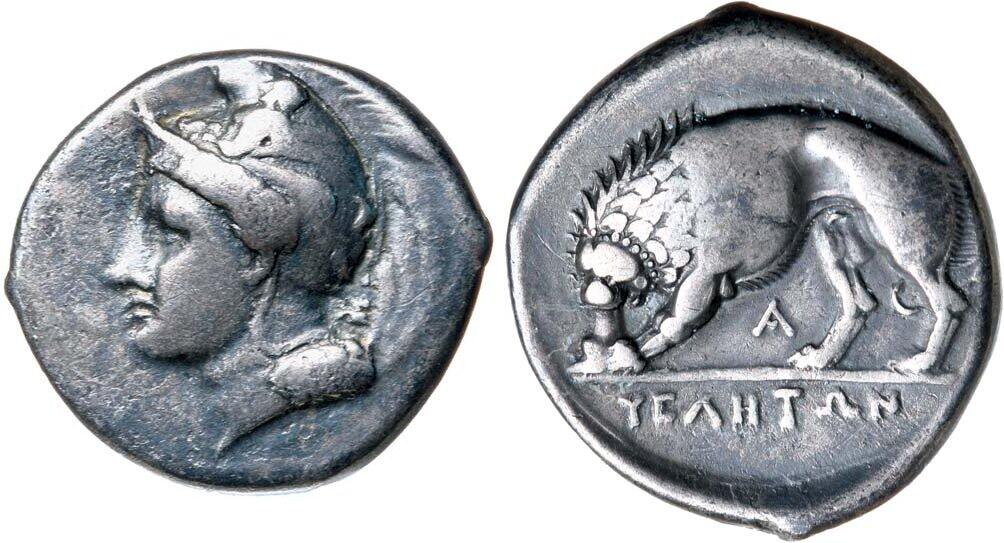Velia, silver, didrachms (350-310 BCE)
From SILVER
350 BCE - 310 BCE Silver 4,082 kg
Description
| ObverseInscription or printing placed on the obverse.: | Head of Athena right, left or three-quarter left, wearing helmet. |
| ReverseInscription or printing placed on the reverse.: | YEΛHTEΩN (Greek).Lion standing to left devouring meat, A below |
Mint and issuing power
| MintIdentifies the place of manufacture or issue of a numismatic object.: | Velia | Ancient regionAncient region.: | Lucania | Modern countryModern country: Italy | AuthorityIdentifies the issuing power. The authority can be "pretended" when the name or the portrait of X is on the coin but he/she was not the issuing power. It can also be "uncertain" when there is no mention of X on the coin but he/she was the issuing power according to the historical sources: |
Chronology
| FromIdentifies the initial date in a range assigned in a numismatic context. | 350 BCE | toIdentifies the final date in a range assigned in a numismatic context.. | 310 BCE | PeriodTime period of the numismatic object.: Classical 480-323 BC |
Physical description
| MetalThe physical material (usually metal) from which an object is made.: | Silver |
Median weightMedian of the weights of numismatic objects (in grams). in grams | 7.55 | DenominationTerm indicating the value of a numismatic object. Examples: tetradrachm, chalkous, denarius.: | didrachm |
StandardStandard.: |
Image

AC 17 - Velia, silver, didrachm, 350-310 BC.jpg [1]
References
| Die study referencePublication of the study: | Williams 19921Williams 1992, groupe VI: variétés 297-384 (D165-D192 et R228-R268). | ||
| Coin series referenceReference to coin series study: | Sear I2Sear I, n° 455-456, RQEMAC3RQEMAC, n° 17, HN Italy4HN Italy, n° 1293, HGC 15HGC 1, n° 1314 | ||
Obverse dies distribution
| FrequencyFrequency of specimen in distribution. ᵖ | Number of obversesNumber of obverse dies. ᵖ (o) | % (o) | Number of coinsNumber of coins. (n) | % (n) | Die nameName(s) of the die(s). |
| 2 | 1 | 3.57 | 2 | 0.28 | 177 |
| 4 | 1 | 3.57 | 4 | 0.56 | 169 |
| 6 | 1 | 3.57 | 6 | 0.84 | 168 |
| 10 | 1 | 3.57 | 10 | 1.4 | 182 |
| 11 | 2 | 7.14 | 22 | 3.09 | 166, 192 |
| 17 | 2 | 7.14 | 34 | 4.78 | 187, 188 |
| 19 | 4 | 14.29 | 76 | 10.67 | 176, 178, 180, 183 |
| 20 | 1 | 3.57 | 20 | 2.81 | 189 |
| 22 | 2 | 7.14 | 44 | 6.18 | 167, 179 |
| 25 | 1 | 3.57 | 25 | 3.51 | 170 |
| 26 | 1 | 3.57 | 26 | 3.65 | 185 |
| 28 | 1 | 3.57 | 28 | 3.93 | 181 |
| 29 | 2 | 7.14 | 58 | 8.15 | 173, 186 |
| 30 | 1 | 3.57 | 30 | 4.21 | 191 |
| 31 | 1 | 3.57 | 31 | 4.35 | 184 |
| 38 | 1 | 3.57 | 38 | 5.34 | 165 |
| 39 | 2 | 7.14 | 78 | 10.96 | 171, 174 |
| 42 | 1 | 3.57 | 42 | 5.9 | 190 |
| 47 | 1 | 3.57 | 47 | 6.6 | 172 |
| 91 | 1 | 3.57 | 91 | 12.78 | 175 |
| Total | 28 of 28 | 99.97 | 712 of 712 | 99.99 |
Reverse dies distribution
no distribution is available
Quantification
| Number of obversesNumber of obverse dies. ᵖ (o) | 28 | Number of singletons (o1)The number of singleton coins. ᵖ | |
| Number of reverse diesNumber of reverse dies. (r) | 41 | Number of coinsNumber of coins. (n) | 712 |
| Coins per obverse dieNumber of coins per obverse die. (n/o) | 25.43 | Coins per reverse dieNumber of coins per reverse die. (n/r) | 17.37 |
| Reverse per obverse ratioRatio of obverse dies divided by reverse dies. (r/o) | 1.46 | Percentage of singletons (o1)number of coins (n) divided by the number of singletons (o1) ᵖ | % |
| Original number of dies (O) (Carter 1983 formula)The estimation of the number of coins according to Carter 1983 ᵖ | 27.03 | Coins struck if 20,000 as average productivity per dieCoins made if the average productivity for obverses (according to Carter) is 20,000. ᵖ | 540,600 |
| Original number of dies (O) (Esty 2011 formula)The estimation of the number of coins according to the singleton formula in Esty 2011 ᵖ (O) | 29.15 | Survival rate if 20,000 as average productivity per dieSurvival rate if average productivity is 20,000. ᵖ | 0.00132 |
| Coverage (o = % of O) (Esty 1984 formula)Esty 1984 - coverage (% of O) ᵖ (o = % of O) | % | Die productivity if survival rate 1/2,000Average productivity if survival rate is 1/2,000. ᵖ | 52,682.2 |
| Weight of silver (in kg) if 20,000 coins per die (O = Carter formula)Carter 1983 * Median weight * 20000 (*10 if gold or electrum) ᵖ | 4,082 kg <br /> 4,082 kg | Die productivity if survival rate 1/5,000Average productivity if survival rate is 1/5,000. ᵖ | 131,705.51 |
Remarks